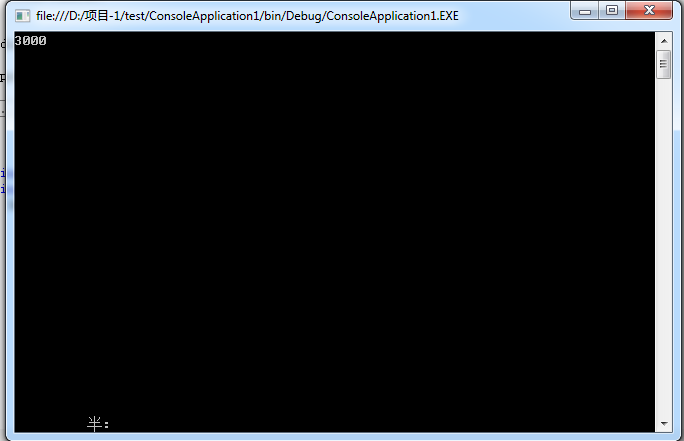每次写博客,第一句话都是这样的:程序员很苦逼,除了会写程序,还得会写博客!当然,希望将来的一天,某位老板看到此博客,给你的程序员职工加点薪资吧!因为程序员的世界除了苦逼就是沉默。我眼中的程序员大多都不爱说话,默默承受着编程的巨大压力,除了技术上的交流外,他们不愿意也不擅长和别人交流,更不乐意任何人走进他们的内心!
最近悟出来一个道理,在这儿分享给大家:学历代表你的过去,能力代表你的现在,学习代表你的将来。我们都知道计算机技术发展日新月异,速度惊人的快,你我稍不留神,就会被慢慢淘汰!因此:每日不间断的学习是避免被淘汰的不二法宝。
当然,题外话说多了,咱进入正题!
简单的总结下对预防并发的理解:预防并发其实就是将并行执行修改为串行执行。(关于数据库并发问题大家可参考我的博客:C# 数据库并发的解决方案(通用版、EF版))
背景
C#命名空间:System.Collenctions和System.Collenctions.Generic 中提供了很多列表、集合和数组。例如:List<T>集合,数组Int[],String[] ......,Dictory<T,T>字典等等。但是这些列表、集合和数组的线程都不是安全的,不能接受并发请求。下面通过一个例子来加以说明,如下:
class Program { private static object o = new object(); private static List<Product> _Products { get; set; } /* coder:天才卧龙 * 代码中 创建三个并发线程 来操作_Products 集合 * System.Collections.Generic.List 这个列表在多个线程访问下,不能保证是安全的线程,所以不能接受并发的请求,我们必须对ADD方法的执行进行串行化 */ static void Main(string[] args) { _Products = new List<Product>(); /*创建任务 t1 t1 执行 数据集合添加操作*/ Task t1 = Task.Factory.StartNew(() => { AddProducts(); }); /*创建任务 t2 t2 执行 数据集合添加操作*/ Task t2 = Task.Factory.StartNew(() => { AddProducts(); }); /*创建任务 t3 t3 执行 数据集合添加操作*/ Task t3 = Task.Factory.StartNew(() => { AddProducts(); }); Task.WaitAll(t1, t2, t3); Console.WriteLine(_Products.Count); Console.ReadLine(); } /*执行集合数据添加操作*/ static void AddProducts() { Parallel.For(0, 1000, (i) => { Product product = new Product(); product.Name = "name" + i; product.Category = "Category" + i; product.SellPrice = i; _Products.Add(product); }); } } class Product { public string Name { get; set; } public string Category { get; set; } public int SellPrice { get; set; } }
本例中,开辟了三个线程,通过循环向集合中添加数据,每个线程执行1000次(三个线程之间的操作是同时进行的,也是并行的),那么,理论上结果应该是3000。
上文中我们讲到: C#命名空间:System.Collenctions和System.Collenctions.Generic 下的列表,数组,集合并不能保证线程安全,并不能防止并发的发生。
本例运行的结果也证明了上述结论的正确性,其结果如下:

由此可见:C#命名空间:System.Collenctions和System.Collenctions.Generic 下的列表,数组,集合确实不能保证线程安全,确实不能预防并发。那么我们应当怎么解决上述问题呢?
还好,自C#2.0以来,LOCK是一直存在的。使用LOCK(互斥锁)是可以做到防止并发的,示例代码如下:
class Program { private static object o = new object(); private static List<Product> _Products { get; set; } /* coder:天才卧龙 * 代码中 创建三个并发线程 来操作_Products 集合 * System.Collections.Generic.List 这个列表在多个线程访问下,不能保证是安全的线程,所以不能接受并发的请求,我们必须对ADD方法的执行进行串行化 */ static void Main(string[] args) { _Products = new List<Product>(); /*创建任务 t1 t1 执行 数据集合添加操作*/ Task t1 = Task.Factory.StartNew(() => { AddProducts(); }); /*创建任务 t2 t2 执行 数据集合添加操作*/ Task t2 = Task.Factory.StartNew(() => { AddProducts(); }); /*创建任务 t3 t3 执行 数据集合添加操作*/ Task t3 = Task.Factory.StartNew(() => { AddProducts(); }); Task.WaitAll(t1, t2, t3); Console.WriteLine(_Products.Count); Console.ReadLine(); } /*执行集合数据添加操作*/ static void AddProducts() { Parallel.For(0, 1000, (i) => { lock (o) { Product product = new Product(); product.Name = "name" + i; product.Category = "Category" + i; product.SellPrice = i; _Products.Add(product); } }); } } class Product { public string Name { get; set; } public string Category { get; set; } public int SellPrice { get; set; } }
引入了Lock,运行结果也正常了,如下:

但是锁的引入,带来了一定的开销和性能的损耗,并降低了程序的扩展性,而且还会有死锁的发生(虽说概率不大,但也不能不防啊),因此:使用LOCK进行并发编程显然不太适用。
还好,微软一直在更新自己的东西:
.NET Framework 4提供了新的线程安全和扩展的并发集合,它们能够解决潜在的死锁问题和竞争条件问题,因此在很多复杂的情形下它们能够使得并行代码更容易编写,这些集合尽可能减少使用锁的次数,从而使得在大部分情形下能够优化为最佳性能,不会产生不必要的同步开销。
需要注意的是:在串行代码中使用并发集合是没有意义的,因为它们会增加无谓的开销。
在.NET Framework4.0以后的版本中提供了命名空间:System.Collections.Concurrent 来解决线程安全问题,通过这个命名空间,能访问以下为并发做好了准备的集合。
1.BlockingCollection 与经典的阻塞队列数据结构类似,能够适用于多个任务添加和删除数据,提供阻塞和限界能力。
2.ConcurrentBag 提供对象的线程安全的无序集合
3.ConcurrentDictionary 提供可有多个线程同时访问的键值对的线程安全集合
4.ConcurrentQueue 提供线程安全的先进先出集合
5.ConcurrentStack 提供线程安全的后进先出集合
这些集合通过使用比较并交换和内存屏障等技术,避免使用典型的互斥重量级的锁,从而保证线程安全和性能。
ConcurrentQueue
ConcurrentQueue 是完全无锁的,能够支持并发的添加元素,先进先出。下面贴代码,详解见注释:
class Program { private static object o = new object(); /*定义 Queue*/ private static Queue<Product> _Products { get; set; } private static ConcurrentQueue<Product> _ConcurrenProducts { get; set; } /* coder:天才卧龙 * 代码中 创建三个并发线程 来操作_Products 和 _ConcurrenProducts 集合,每次添加 10000 条数据 查看 一般队列Queue 和 多线程安全下的队列ConcurrentQueue 执行情况 */ static void Main(string[] args) { Thread.Sleep(1000); _Products = new Queue<Product>(); Stopwatch swTask = new Stopwatch();//用于统计时间消耗的 swTask.Start(); /*创建任务 t1 t1 执行 数据集合添加操作*/ Task t1 = Task.Factory.StartNew(() => { AddProducts(); }); /*创建任务 t2 t2 执行 数据集合添加操作*/ Task t2 = Task.Factory.StartNew(() => { AddProducts(); }); /*创建任务 t3 t3 执行 数据集合添加操作*/ Task t3 = Task.Factory.StartNew(() => { AddProducts(); }); Task.WaitAll(t1, t2, t3); swTask.Stop(); Console.WriteLine("List<Product> 当前数据量为:" + _Products.Count); Console.WriteLine("List<Product> 执行时间为:" + swTask.ElapsedMilliseconds); Thread.Sleep(1000); _ConcurrenProducts = new ConcurrentQueue<Product>(); Stopwatch swTask1 = new Stopwatch(); swTask1.Start(); /*创建任务 tk1 tk1 执行 数据集合添加操作*/ Task tk1 = Task.Factory.StartNew(() => { AddConcurrenProducts(); }); /*创建任务 tk2 tk2 执行 数据集合添加操作*/ Task tk2 = Task.Factory.StartNew(() => { AddConcurrenProducts(); }); /*创建任务 tk3 tk3 执行 数据集合添加操作*/ Task tk3 = Task.Factory.StartNew(() => { AddConcurrenProducts(); }); Task.WaitAll(tk1, tk2, tk3); swTask1.Stop(); Console.WriteLine("ConcurrentQueue<Product> 当前数据量为:" + _ConcurrenProducts.Count); Console.WriteLine("ConcurrentQueue<Product> 执行时间为:" + swTask1.ElapsedMilliseconds); Console.ReadLine(); } /*执行集合数据添加操作*/ /*执行集合数据添加操作*/ static void AddProducts() { Parallel.For(0, 30000, (i) => { Product product = new Product(); product.Name = "name" + i; product.Category = "Category" + i; product.SellPrice = i; lock (o) { _Products.Enqueue(product); } }); } /*执行集合数据添加操作*/ static void AddConcurrenProducts() { Parallel.For(0, 30000, (i) => { Product product = new Product(); product.Name = "name" + i; product.Category = "Category" + i; product.SellPrice = i; _ConcurrenProducts.Enqueue(product); }); } } class Product { public string Name { get; set; } public string Category { get; set; } public int SellPrice { get; set; } }
结果如下:

从执行时间上来看,使用 ConcurrentQueue 相比 LOCK 明显快了很多!
1.BlockingCollection 与经典的阻塞队列数据结构类似,能够适用于多个任务添加和删除数据,提供阻塞和限界能力。
2.ConcurrentBag 提供对象的线程安全的无序集合
3.ConcurrentDictionary 提供可有多个线程同时访问的键值对的线程安全集合
4.ConcurrentQueue 提供线程安全的先进先出集合
5.ConcurrentStack 提供线程安全的后进先出集合
上面的实例可以使用ConcurrentBag吗?当然是可以的啦,因为:ConcurrentBag 和 ConcurrentQueue一样,操作的对象都是集合,只不过方式不同罢了!同理:小虎斑们也可以尝试使用 ConcurrentStack 在这里,我仅仅贴上使用ConcurrentBag的代码,如下:
class Program { private static object o = new object(); /*定义 Queue*/ private static Queue<Product> _Products { get; set; } private static ConcurrentBag<Product> _ConcurrenProducts { get; set; } /* coder:天才卧龙 * 代码中 创建三个并发线程 来操作_Products 和 _ConcurrenProducts 集合,每次添加 10000 条数据 查看 一般队列Queue 和 多线程安全下的队列ConcurrentQueue 执行情况 */ static void Main(string[] args) { Thread.Sleep(1000); _Products = new Queue<Product>(); Stopwatch swTask = new Stopwatch();//用于统计时间消耗的 swTask.Start(); /*创建任务 t1 t1 执行 数据集合添加操作*/ Task t1 = Task.Factory.StartNew(() => { AddProducts(); }); /*创建任务 t2 t2 执行 数据集合添加操作*/ Task t2 = Task.Factory.StartNew(() => { AddProducts(); }); /*创建任务 t3 t3 执行 数据集合添加操作*/ Task t3 = Task.Factory.StartNew(() => { AddProducts(); }); Task.WaitAll(t1, t2, t3); swTask.Stop(); Console.WriteLine("List<Product> 当前数据量为:" + _Products.Count); Console.WriteLine("List<Product> 执行时间为:" + swTask.ElapsedMilliseconds); Thread.Sleep(1000); _ConcurrenProducts = new ConcurrentBag<Product>(); Stopwatch swTask1 = new Stopwatch(); swTask1.Start(); /*创建任务 tk1 tk1 执行 数据集合添加操作*/ Task tk1 = Task.Factory.StartNew(() => { AddConcurrenProducts(); }); /*创建任务 tk2 tk2 执行 数据集合添加操作*/ Task tk2 = Task.Factory.StartNew(() => { AddConcurrenProducts(); }); /*创建任务 tk3 tk3 执行 数据集合添加操作*/ Task tk3 = Task.Factory.StartNew(() => { AddConcurrenProducts(); }); Task.WaitAll(tk1, tk2, tk3); swTask1.Stop(); Console.WriteLine("ConcurrentQueue<Product> 当前数据量为:" + _ConcurrenProducts.Count); Console.WriteLine("ConcurrentBag<Product> 执行时间为:" + swTask1.ElapsedMilliseconds); Console.ReadLine(); } /*执行集合数据添加操作*/ /*执行集合数据添加操作*/ static void AddProducts() { Parallel.For(0, 30000, (i) => { Product product = new Product(); product.Name = "name" + i; product.Category = "Category" + i; product.SellPrice = i; lock (o) { _Products.Enqueue(product); } }); } /*执行集合数据添加操作*/ static void AddConcurrenProducts() { Parallel.For(0, 30000, (i) => { Product product = new Product(); product.Name = "name" + i; product.Category = "Category" + i; product.SellPrice = i; _ConcurrenProducts.Add(product); }); } } class Product { public string Name { get; set; } public string Category { get; set; } public int SellPrice { get; set; } }
执行结果如下:

对于并发下的其他集合,我这边就不做代码案列了!如有疑问,欢迎指正!
@陈卧龙的博客